It’s been about four months since I wrote about my difficulties learning Japanese. For a while after that, it was hard to find a way to stay on track with my learning. I caught up with my WankiKani reviews, but I didn’t know how to go about studying everything else. Then, inspiration struck me: a language journal.
Getting Inspired
At my school, students sometimes submit notebooks called UPノート (nooto, notebook). One day, my JTE (Japanese Teacher of English) asked me to check a few for mistakes. The students use them in different ways: sometimes they practice spelling, sometimes they practice textbook dialogues, and sometimes they make up their own sentences. It’s such a basic idea, and yet it never occurred to me to incorporate it into my Japanese studies.
First Step: Buying a Journal
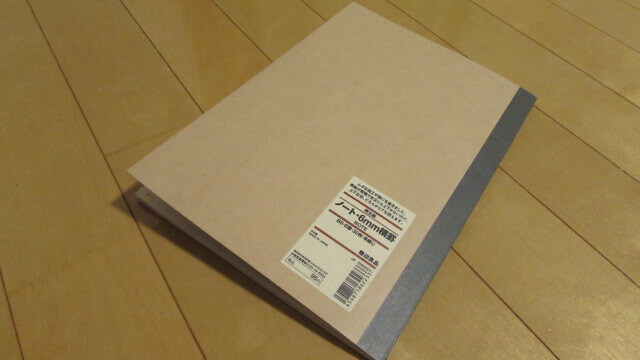
For my language journal, I decided to buy a cheap, plain-looking notebook. I know Japan is home to thousands of cute notebooks featuring every kind of character under the sun, but hear me out. I know I’m a perfectionist. If I bought a notebook that’s pretty on the outside, I’d want the inside to look just as neat and nice. I also know that I don’t work like that. Corrections alone could be all over the place. So, I bought a notebook that I wouldn’t mind “ruining.” It perfectly represents the point of a language journal: messing up a lot as you try to make sense of another language.
What about a digital language journal? You could make one, but I feel a physical one is better. To begin with, there have been multiple studies that show handwriting notes helps retain information better than typing them. Aside from that, I think it helps get you in the right frame of mind for studying. With how often we’re on some sort of digital device, stepping away and using a pencil and paper lets you differentiate between “study” time and “everything else” time.
Using ALL the Colors
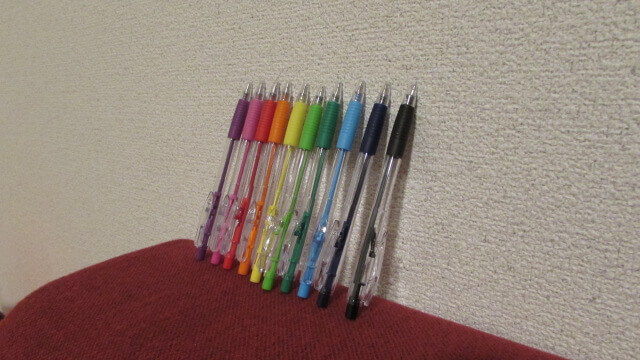
When I was in school, there was a rule that said we could only use blue or black ink, and by the time I was in maybe 4th grade, pencils were only for math. In the Japanese junior high school I work at, though, those rules are off the table. Students usually write in pencil, but they have a host of pens and highlighters of all different colors. The teachers also have an array of chalk to choose from, and they usually use different colors to highlight different information. This is brilliant. It’s a great way to organize information. A simple visual cue like a color immediately tells you what you’re looking at without having to try and remember or leaving yourself some long note. So, I took a trip to Daiso (100 yen store) and bought a pack of colored pens. I thought about how I wanted to organize my language journal, as well as which colors would represent each section. So far, I’ve designated 7 of the 10 colors to different things.
Dark Green: The Study Source
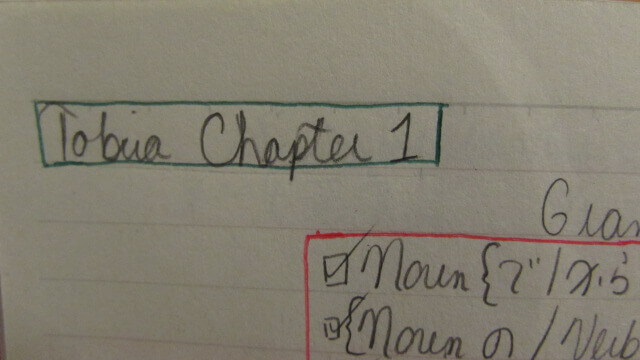
The first thing I wrote down in my language journal was where all of my work was coming from. Currently, I’m using Tobira to study for the JLPT in July. So, for my “study source,” I wrote Tobira Chapter 1. Of course, it doesn’t have to be a textbook. If I was trying to read a light novel, my study source could be a chapter from the book. I like breaking things up into smaller chunks like chapters so I don’t feel compelled to avoid trying anything outside of that one thing. This way, I could work on maybe three chapters from Tobira and then try learning from a chapter of manga, for example.
Study Goals
For the rest of my categories, I write out study goals–things I want to achieve per session. At first, my goal was consistently to check off all the items on each list. After a while, though, I thought to myself, “Isn’t that always going to be the goal? Do you really need to write that out?” So, I decided to be more specific with my goals. I try to look at where I am in understanding the information I want to go over and how I want to improve by the end. For example, if I’m starting a new chapter in my textbook, one goal could be to prepare the vocabulary for memorization (i.e. making Anki flashcards). I also keep track of when I’ve finished a list of goals and if I hit any problems along the way so I know what to work on next time.
Light Blue: Learning
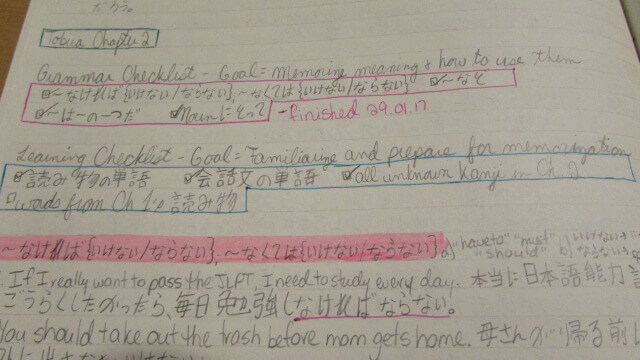
The learning section is for anything new I’m going over. Since I recently started a new chapter in my textbook, things like making flashcards for the chapter’s kanji and practicing using the chapter’s vocabulary appear on my learning lists. This doesn’t mean old things I’ve learned can’t appear on here. I have a LOT of flashcards full of vocabulary; however, I don’t necessarily know how some of the words or phrases are used. So, going over those would count as “learning” more about them.
Pink: Grammar
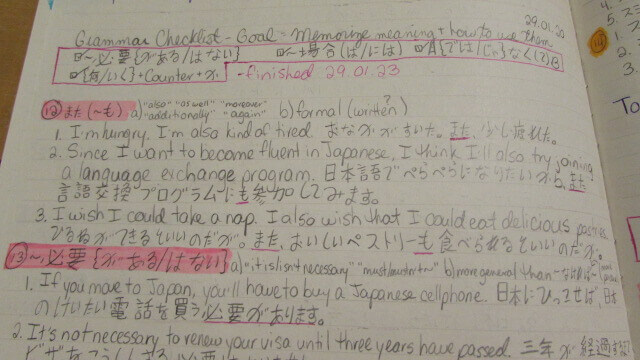
Although I learn new grammar with each textbook chapter, I decided to give grammar its own section and color. I did this because remembering grammar points that have similar words (like anything that incorporates 〜よう[~you]) is difficult for me. Separating it allows me to easily find past points that I’ve studied so I can look them over again if necessary.
For this section, I usually choose maybe three or four points from my textbook. Then, I’ll write out the individual point I’m going over with one or two notes next to it. Beneath those, I write practice sentences that use the grammar point. The numbers next to the highlighted grammar point refer to its place in the chapter list. Since I haven’t used my language journal for learning things I’ve read in novels or heard in videos, I’m not sure if I’d number it. Thinking about it now, though, I’d likely note the page number or use a time marker so I could easily refer back to the source.
Orange: Review
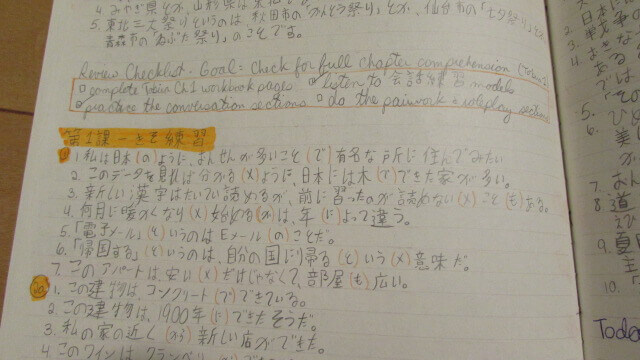
For anything I’m reviewing, I mark it in orange. It’s a pretty bold color, so even if I’m in the middle of studying a chapter, I can easily see what’s part of the chapter and what’s review work. I also don’t feel like I have to wait until the end of a chapter to start reviewing it; if it’s been a few days and I can’t remember how to use a grammar point, I have no issue using my language journal to go over it again. So far, the review section has exclusively been used for going over past textbook work as well as for problems in Tobira’s grammar workbook.
Light Green: Study
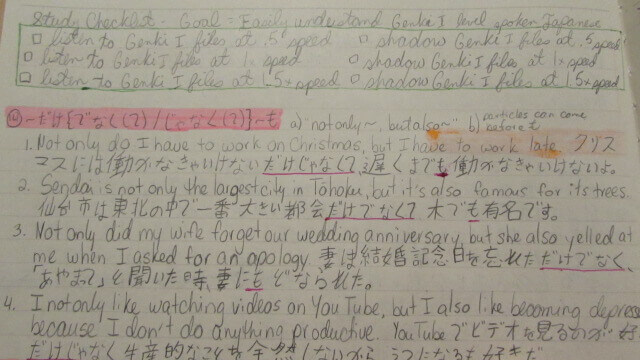
So, what’s the difference between “review” and “study”? I think of reviewing as something specific, whereas studying can be practicing more general things. I’d probably review things that I’ve recently learned, but I’d study things that are further removed from me. If I’m listening to old conversations files from a beginners textbook, for example, that’s studying. If I’m listening to a previous chapter’s dialogue, though, that’s more like reviewing. As with everything else here, it’s a personal preference and merely acts as a way to differentiate everything I’m doing. I can see orange and know that it refers to something I recently went over, whereas seeing light green lets me know that I looked at something I may continue to struggle with. In conclusion, for me, “review” means to refresh, but “study” means to solidify it in my mind.
Red: Corrections
This is pretty self-explanatory. Red seems to be the universal color for correcting work, so I decided to go along with the trend. I haven’t taken the time to correct my work yet, so everything still looks pretty nice and neat. Soon, though…
Dark Blue: Accomplishments
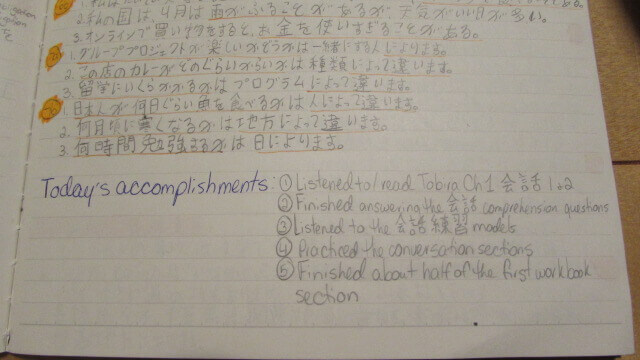
I like to end every language journal session by listing the day’s accomplishments. Even if I only did one thing, I’ll put it on my list. It’s a good way to remind myself that I made some progress, even if it was just a little. What I do not do is list what still needs to get done. As mentioned earlier, I’m a perfectionist. If I see a number of things I “failed” to do, I’ll discredit my accomplishments. Instead, whenever I finish a box of items, I mark the day I completed it. I still get to keep track of what needs to get done, but I don’t fall into the trap of defining my day by what’s left over. It’s really helped me stay motivated and continue using my language journal.
Get Started on Yours!
I’m extremely surprised that I’ve been able to study consistently throughout the last few weeks. In the past, it’s been very difficult to stick to a routine. With my language journal, though, I think I’ve finally found a method that works for me. This is how I set mine up, but you can set your own language journal up however you like! Whether you want to focus on grammar or writing actual journal entries, you’re free to do whatever suits your needs! As far as checking your work, you can always use Lang-8 to post things you want looked over. The Learning Japanese subreddit may also prove to be helpful. Good luck and happy studying!
Do you think a language journal could help you with your studies? Have you already started one? Let us know in the comment section below or on social media how you set yours up!

Featured Sponsor - JAST
The sweetest romance and the darkest corruption, the biggest titles and the indie darlings; for visual novels and eroge, there's nowhere better.
Big thank you to our supporters
From their continous support, we are able to pay our team for their time and hard work on the site.
We have a Thank-You page dedicated to those who help us continue the work that we’ve been doing.
See our thank you page





